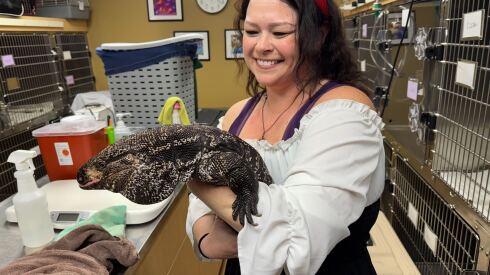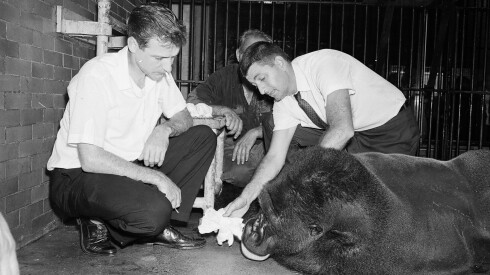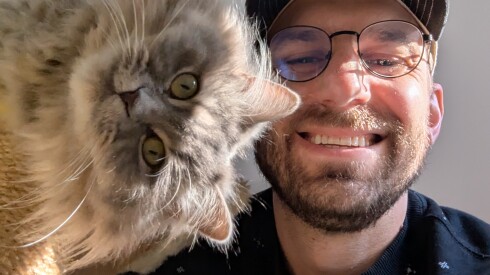A coyote walked into a Quizno’s in downtown Chicago on a spring day in 2007. It skipped the sandwich counter and settled in among the drinks in an open cooler as nervous customers took pictures with their cellphones.
The city has seen its share of exotic animals, crawling, slithering and swinging, unattended in Chicago streets and waterways, making the city’s reputation as a concrete jungle a little too on the nose. Some have made local and national news, including Chance the Snapper, a cougar found in Roscoe Village and a peacock strolling down an alley.
Chicago Animal Care and Control responded to a call of a stray peacock in 2011. The bird is pictured walking around a room in the department because it was too big for a cage. Gilbert Baez tries to lure “Fluffy” the peacock with a piece of hot dog, after he came to the Chicago Animal Care and Control Center to retrieve the bird.
Keith Hale/Chicago Sun-Times
Experts are often called in to manage the situation, whether it’s Chicago Animal Care and Control, a local veterinary hospital or an animal shelter.
Here are some unusual creatures spotted in Chicago’s neighborhoods and suburbs, on highways and in parks.
Wild things
Willis the monkey. A number of unusual animal sightings are exotic pets, which often end up in Chicago through the exotic animal trade. Angela Rayburn, operations manager with Animal Care and Control, recalled a 2021 email from a woman reporting a stray monkey in her backyard. “I’m thinking, ‘This is an autocorrect; maybe it’s a donkey,’” she said.
The woman brought the monkey into her home, which struck Rayburn as an odd and dangerous choice. When the animal control officer arrived, he found that the woman had been illegally keeping the monkey as a pet.
“She got it from Indiana as a baby, and it was about a year and a half at that point,” Rayburn said. “I think it became too much for her.”
The woman agreed to release the monkey to Animal Care and Control, and he was relocated to the Texas location of Born Free USA, an animal sanctuary and advocacy organization. He’s now named Willis, after the Willis Tower in Chicago.
“Most primates live in large, complex social hierarchies,” said Angela Grimes, CEO of Born Free USA. “They occupy dynamic and challenging natural habitats, they thrive in company of their own kind and they have long childhoods.” Caging wild animals in a private home means these needs cannot be met, and that can put the owner or any first responders at risk, she said.
Gomez Addams the tegu. Some pet owners bite off more than they can chew and end up abandoning their animals outside. That’s likely what happened with Gomez, an Argentine tegu lizard found wandering the streets of Wheeling, Ill.
“Escaped pets, usually, if somebody wants them, they’ll be searching for them,” said Kim Kelleher, assistant manager at the Chicago Exotics Animal Hospital in Skokie, Ill. After the hospital posted his photo on social media and contacted the nearby police station, nobody claimed him.
Kim ended up adopting Gomez herself. But normally in these cases, the animal is rehomed or sent to a sanctuary where it can live out the rest of its life.
Dusty the donkey. Many animals like sheep, pigs and chickens have strayed from the farm for a trip to the big city. Sometimes they’re abandoned by their caretakers, like in the case of three donkeys found stranded in a trailer on the Chicago Skyway.
Often, farm animals fall or jump out of a truck while being transported on the highway. That’s what happened to another donkey in 2019.
According to ABC 7, Dusty was being driven to a new owner when he slipped out the back of a trailer on I-90. The 4-foot-tall donkey was wandering down the highway near Arlington Heights Road until Sgt. Bonnie Busching drove by, got out of her car and guided him to the shoulder while waiting for Illinois Department of Transportation backup.
Dusty was eventually brought to his new owner, injury-free.
Sinbad the gorilla. Animal Care and Control will tap the expertise of Lincoln Park Zoo for some animal escapes. But sometimes animals escape the Lincoln Park Zoo. Back in 1964, a 500-pound gorilla named Sinbad escaped his enclosure through a door left unlocked by a keeper. He didn’t go beyond the zoo grounds, but for 20 minutes, he had staff scrambling.
According to the Chicago Sun-Times, Sinbad never entered the spectator area. Instead, he ran around the interior hallways of the Monkey House before entering the food room, where he banged on pots and pans and munched on vegetables. Staff waved snakes and fire hoses in an attempt to scare the gorilla back into his enclosure, a tactic they used when a different gorilla escaped in 1950. “Sinbad is not afraid of anything,” zoo director Dr. Lester E. Fisher told the Sun-Times.
Twenty armed policemen were called to assist, but they were not needed. Eventually, zoo staff shot Sinbad with an anesthetic needle and they were able to move him back into his enclosure, where he slept it off.
Visitors shouldn’t worry — it’s rare for an animal to escape Lincoln Park Zoo. The last one that made headlines was Otto the gorilla back in 1982.
A cougar’s in my yard. Now what?
Chicago Animal Care and Control officers get hands-on training to make sure animals can be contained or confined without causing them more stress. But for animals that may require more expertise, the department will work with rescue organizations, veterinary hospitals and sanctuaries. They’ll even get help from the Chicago Police Department, especially when crowd control is needed.
Rayburn says if residents encounter stray animals, she recommends three steps:
Be safe. If you feel your safety is at risk and you cannot get away, make loud noises and wave your arms to appear larger.
Call 311 and make a detailed report. Rayburn says animals are usually on the move, but it’s helpful to share the general area where you saw them and in what direction they were moving. Be sure to include your contact information for follow-up questions.
Avoid attracting animals. Rayburn advises keeping your outdoor trash in check. “If you have your garbage can lids open or there’s garbage in the alley … it’s an attractant, not only for wildlife but for outdoor cats, other animals, rats,” she said. Rayburn also recommends getting rid of unnecessary brush or trimming overgrown trees to eliminate places where wildlife can hide.
She said the primary goal is safety for both people and animals.
“Apprehend it safely, make sure it’s contained safely,” Rayburn said. The department aims to “find a live outcome or placement for it. We always want the animals to live out their best life.”





